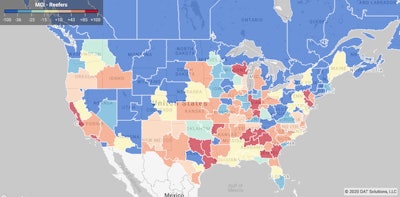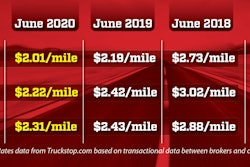Activity on the DAT network of load boards slowed during the Fourth of July holiday week as the number of loads posted declined 20% compared to the previous week. The number of truck posts fell 8.5%.
Average rates moved higher, however, as shippers pushed freight out the door before the end of the quarter on June 30. DAT’s Ratecast predictive pricing model expects July 5 to have been the peak for the national dry van rate and July 7 to be the high point for reefers. Look for rates to decline through the rest of the summer.
National average spot rates, June
**Van: $1.81 per mile, 21 cents above May
**Flatbed: $2.07 per mile, up 17 cents
**Reefer: $2.15 per mile, up 12 cents
Those are rolling averages for the month and current rates have trended upward. On July 5, the van spot rate averaged $2.03 a mile, the flatbed rate was $2.15, and the reefer rate was $2.30.
Peak produce: Trend to watch
The USDA reported that seasonal truckloads of produce dropped 17% last week on fewer imports. Domestic shipments rose 2% week over week; that’s around 600 additional loads over the prior week. Produce volumes from Mexico typically tail off quickly this time of year and are now down 27% week over week.
On the West Coast, all produce markets reported tight capacity. May and June are peak months for California strawberries in the Watsonville-Salinas regions of the San Francisco market. Regional moves from there to Ontario, Los Angeles, and Fresno averaged $3.01, $3.05, and $4.04 per mile respectively.
 DAT’s Market Conditions Index map for reefers shows the demand for capacity remains hot across both California and areas of the Southeast.
DAT’s Market Conditions Index map for reefers shows the demand for capacity remains hot across both California and areas of the Southeast.In Texas, Fort Worth and Lubbock were hot markets for available trucks. The average rate on 58 origin-destination pairings increased from $1.90 to $2.09 per mile, with shorter, regional moves to Shreveport, Louisiana, and Little Rock, Arkansas, paying averages of $3.23 and $2.94, respectively.
Market to watch: New York State
The COVID-19 coronavirus continues to create volatility in the marketplace. To get a better read on what to expect going forward, we’re keeping a close eye on New York state, which was hard hit initially and is now in the third phase of reopening.
New York is a case study for how freight markets might recover. Phase one started in mid-May and included agriculture, construction, and manufacturing businesses, provided each region met certain health metrics. Testing ramped up and positive results actually declined, so June was the first full month in which the state’s main manufacturing markets were open: Brooklyn, Buffalo, Rochester, Syracuse, Elmira and Albany. Combined, those markets had a 26% increase in outbound van volume last month.
If COVID numbers hold steady, New York as a freight market can shine a light on what the post-July 4 recovery can look like as other industries there come back on line. DAT’s COVID-19-related market updates are available via this link.










